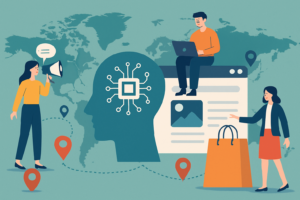How AI and Marketing Help Brands Localise Globally


I’ve worked with brands trying to scale internationally, and I’ve seen one thing hold across the board—global growth doesn’t mean much if your message doesn’t resonate locally.
That’s exactly where AI and Marketing come together as a powerful duo.
It’s no longer enough to translate a tagline or adjust a colour scheme. People want to feel like you get them.

Cultural nuance isn’t just a nice-to-have; it’s a business advantage.
In my experience, the brands that succeed in new markets are the ones that respect cultural differences.
It’s not about checking boxes—it’s about understanding the heart of what matters to people in that region.
I’ve seen campaigns fall flat simply because they missed a subtle cultural cue. On the flip side, when you nail that nuance? The impact is massive.
Localization isn’t only about the language; it’s about adapting every element of your marketing strategy to the local context—tone, values, humour, and even the visual design.
This deeper level of understanding is what drives a real connection with international audiences.
When used strategically, AI and Marketing give us an insider’s view into how different regions behave, think, and feel.
With AI pulling the data and marketing guiding the message, we’re able to develop campaigns that land with precision and empathy.
No more guessing what will work in a new market—it’s about data-driven, real-time insights.
From tracking local trends to analyzing social conversations, AI enables us to gather insights that would take human teams weeks to compile.
By tapping into AI’s real-time capabilities, brands can act on insights faster and avoid costly mistakes in the localization process.
In the past, personalization in marketing often felt like a luxury reserved for the biggest brands.
But today, with the help of AI and Marketing, it’s possible to deliver hyper-targeted messaging to audiences across the globe at scale.
I can segment audiences based on their behaviour, purchase intent, preferences, and even the type of content they engage with.
This allows me to adjust messaging, visuals, and offers so they align with local needs and desires.
I once worked with a brand that didn’t think their global customers were interested in eco-friendly products—until we used AI to discover that their local markets in Europe were eager for sustainability options. That’s the power of personalization at scale.
Maintaining consistency in your brand’s voice across different languages and regions is no easy feat.
While AI and Marketing tools can help with localization, it’s critical that the brand’s personality is preserved, no matter the translation.Smart AI tools today aren’t just about literal translation—they’re about contextual adaptation.
They understand tone, intent, and brand voice. They ensure that your message remains true to your brand while adapting to local nuances.
For instance, humour that works in New York might not resonate in Tokyo, but AI can help strike the perfect tone for each region.
One of the greatest benefits of AI is its ability to predict shifts in consumer behaviour.Predictive analytics allow me to uncover untapped micro-segments of customers who might have been overlooked.
With AI and Marketing, I can identify emerging trends before they become mainstream, targeting audiences that are highly likely to engage with the brand.
AI tools can analyze massive amounts of data—social media activity, browsing habits, and even weather patterns—and use that to predict consumer intent. This means I can adjust campaigns proactively, ensuring we’re speaking to the right people with the right message at exactly the right time.
AI doesn’t replace creative teams—it empowers them. I often find that local creators bring invaluable cultural insights that can make or break a campaign.
Once the content is created, we use AI-powered tools to optimize everything from copy to visuals, ensuring that what’s produced truly resonates with audiences.
For example, I once helped a client create a campaign that was tailored specifically for a region, using AI to test which type of creative performed best in real-time.
We tested everything—images, language, even the placement of call-to-action buttons—and the result was a campaign that felt hyper-local while staying true to the global brand.
Spotify and Netflix are examples of brands doing localization right. Both of these companies use AI and Marketing to customize their offerings by region.
Spotify personalizes playlists and music recommendations based on location and listening patterns, ensuring each user feels like the service understands them.
Netflix takes a similar approach with regional thumbnails and show recommendations.
These brands show us that it’s possible to create a global presence while deeply understanding local cultures. They use AI to enhance their marketing strategies and ensure they connect with audiences on a personal level, whether they’re in São Paulo, Seoul, or Stockholm.
The future of AI and Marketing in localization is incredibly exciting.As AI technology continues to evolve, we can expect even more advanced tools for real-time localization.
Imagine launching a campaign that adjusts itself based on live feedback from local audiences—optimizing creative, timing, and targeting as the campaign runs.
Generative AI is also becoming more prominent in content creation. With AI-powered systems able to produce tailored content for specific markets almost instantly, localization will become faster, more efficient, and more accurate than ever before.
However, it’s important to balance automation with authenticity. People still want to feel like they’re interacting with a real brand, not just a machine.
The key to success will always lie in blending human creativity with the efficiency of AI-powered marketing.
In my experience, AI and Marketing aren’t just a nice combination for localization—they’re essential.
When brands use AI to understand local markets, personalize their messaging, and predict shifts in behaviour, they can successfully scale internationally. But the true magic happens when AI is used to augment human insight and creativity.
In the end, global brands aren’t built by shouting louder—they’re built by speaking to people like they belong.
By combining the power of AI and Marketing, you can ensure your message resonates on a local level, driving growth and creating authentic connections across the world.